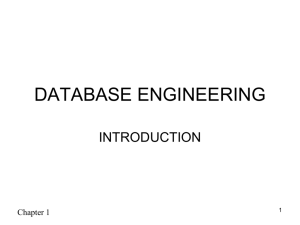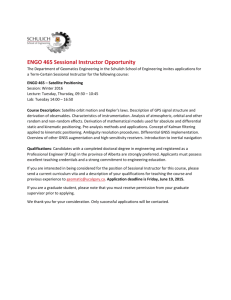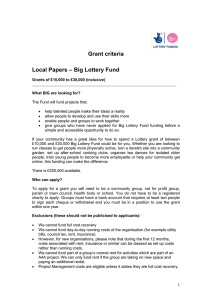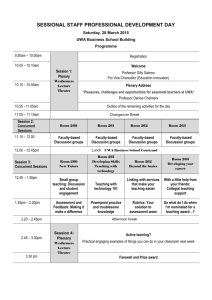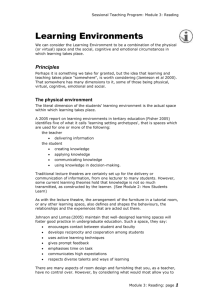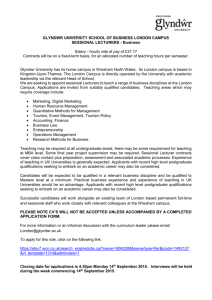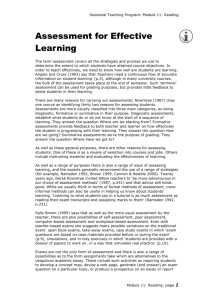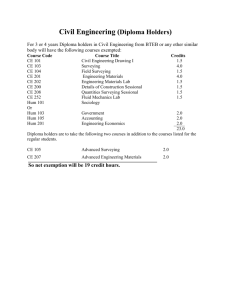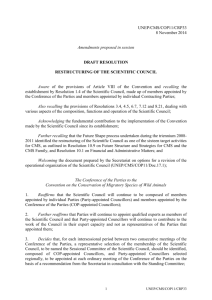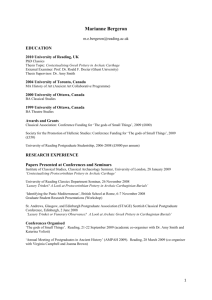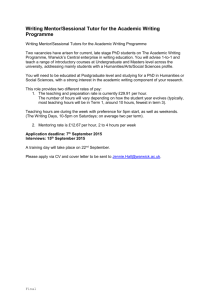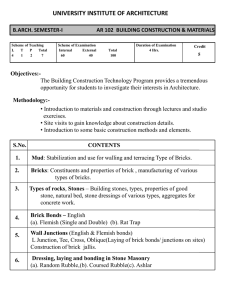Introduction - University of Adelaide
advertisement
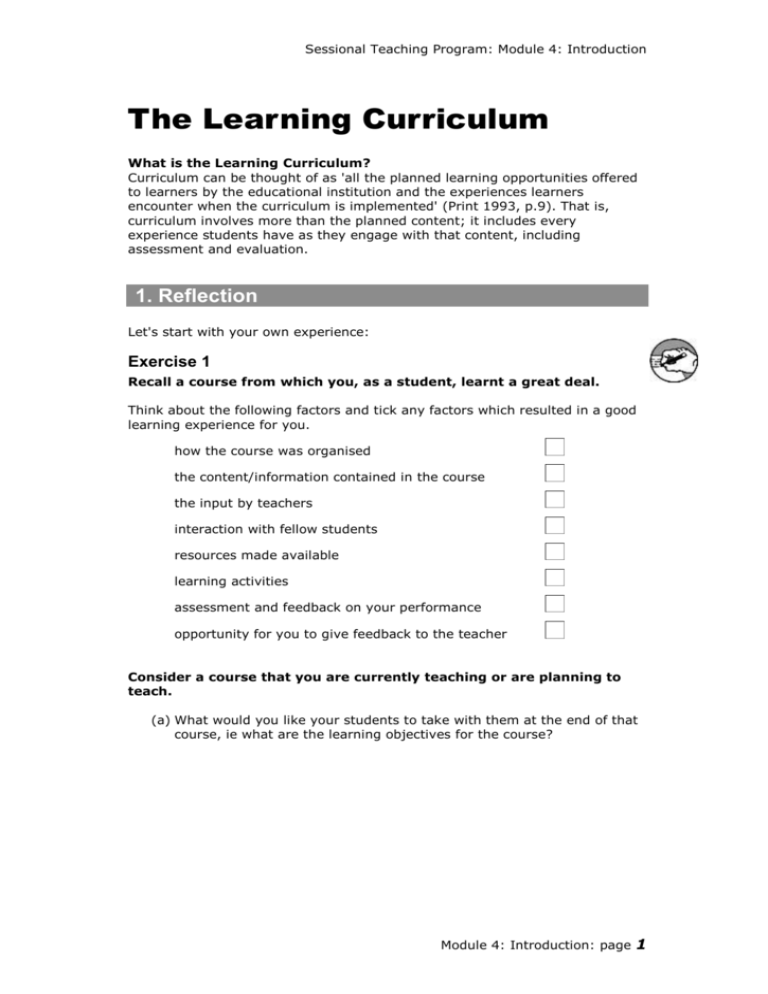
Sessional Teaching Program: Module 4: Introduction The Learning Curriculum What is the Learning Curriculum? Curriculum can be thought of as 'all the planned learning opportunities offered to learners by the educational institution and the experiences learners encounter when the curriculum is implemented' (Print 1993, p.9). That is, curriculum involves more than the planned content; it includes every experience students have as they engage with that content, including assessment and evaluation. 1. Reflection Let's start with your own experience: Exercise 1 Recall a course from which you, as a student, learnt a great deal. Think about the following factors and tick any factors which resulted in a good learning experience for you. how the course was organised the content/information contained in the course the input by teachers interaction with fellow students resources made available learning activities assessment and feedback on your performance opportunity for you to give feedback to the teacher Consider a course that you are currently teaching or are planning to teach. (a) What would you like your students to take with them at the end of that course, ie what are the learning objectives for the course? Module 4: Introduction: page 1 Sessional Teaching Program: Module 4: Introduction (b) Which of your own experiences above can you utilise to help students learn? 2. What would you like to learn from this module? I would like to learn about... YES Not Yet NO/NA 1. principles of curriculum development (3.1) 2. linking course objectives with learning experiences and assessment tasks (3.1) 3. tips on curriculum development and implementation (4) 4. an action plan for applying principles of curriculum development and implementation (5) 5. more detailed information on curriculum (3.2) 6. suggestions for more in-depth reading about curriculum (3.2) Module 4: Introduction: page 2 Sessional Teaching Program: Module 4: Introduction 3. Principles 3.1 Curriculum Development Cycle It is important that you make clear to students what the links are between the expected learning outcomes (i.e. learning objectives), the course content, what the students are required to do (i.e. learning experiences) and the assessment tasks. The links between learning objectives, course content, student learning experiences, and assessment tasks, together with a course evaluation process, form the basis of a curriculum development cycle. [adapted from Kiley, M. (1994) Guidelines for Curriculum Development and Review at the University of Adelaide. <http://www.adelaide.edu.au/clpd/lta/download/guidelines_curric.pdf>] Module 4: Introduction: page 3 Sessional Teaching Program: Module 4: Introduction Some important ideas about curriculum are contained in the following quotes: "The key to curriculum planning is to forge educationally sound and logical links between planned intentions (expressed as objectives), course content, teaching and learning methods, and the assessment of student learning while taking account of student characteristics... The approach is ... called 'alignment', and is achieved when the objectives express the kind of understandings we expect of students, the teaching encourages and supports students to undertake activities likely to achieve those understandings, and the assessment tasks tell students what is required and also show whether the objectives have been met ... Curriculum development should be an ongoing process. In practice, curriculum development can and does start with any of the linked elements named above" (Cannon & Newble 2003, pp.142-3) "What is constructive alignment? CA has two aspects. The 'constructive' aspect refers to what the learner does is to construct meaning through relevant learning activities. The 'alignment' aspect refers to what the teacher does, which is to set up a learning environment that supports the learning activities appropriate to achieving the desired outcomes. The key is that the component in the teaching system, especially the teaching methods used and the assessment tasks, are aligned to the learning activities assumed in the intended outcomes. The learner is in a sense 'trapped' and finds it difficult to escape without learning what is intended should be learned." (Biggs 2003, p.1) Module 4: Introduction: page 4 Sessional Teaching Program: Module 4: Introduction Aligning learning objectives with learning experiences and assessment tasks Here are some examples of how learning objectives (identified by key words) can align with learning experiences and assessment tasks Key words in a course objective Learning experiences Assessment tasks ...describe... Readings ...write a description... ...discuss... ...small group discussion... Active participation in tutorial group ...search literature for range of views on topic... ...hypothesise... ...a research paper... ..write a summary of the views and highlight similarities and differences... ...oral presentation of findings... ...students provided with models of how to develop an hypothesis Research proposal ...models of hypothesis statements - guided practice Module 4: Introduction: page 5 Sessional Teaching Program: Module 4: Introduction Exercise 2 State some of the learning objectives for a course you teach. In the table below, rate the effectiveness of the listed aspects of your curriculum in promoting the learning objectives you identified Aspect of curriculum Effectiveness in promoting student learning very some Describe/Comment not Organization Content Teacher input Student-student interaction Resources Learning activities Assessment & feedback to students Students' feedback to teacher Module 4: Introduction: page 6 Sessional Teaching Program: Module 4: Introduction Exercise 3 Reflect on how the various aspects of the curriculum influence students' learning. Exercise 4 In the table below, list learning experiences and assessment tasks which align with the suggested learning objectives Key words in a course objective Learning experiences Assessment tasks ...identify... ...apply... ...critically evaluate... other... Module 4: Introduction: page 7 Sessional Teaching Program: Module 4: Introduction 3.2 Reading For a general overview of the topic see the "The Learning Curriculum" (Module 4) Reading on the CLPD Sessional Teaching website. Go to the STP Modules web page <http://www.adelaide.edu.au/clpd/sessional/stp/> 4. Tips The following ideas can help you devise a curriculum in which the course goals, learning objectives, learning experiences, assessment tasks and evaluation strategies are constructively aligned: Be precise about your course goals. Write down what you, as a teacher, want to achieve in this course. Be very clear about students' learning objectives. Write down just what it is you want your students to learn from your course. Consider more than the content. Consider how the University's Graduate Attributes apply in your discipline area and at the students' level of development. You could also take into account the interests and expertise of those teaching, topics covered in core literature, and the ways of thinking, researching and communicating in your discipline. Be aware of how your course might fit with what students are doing in other courses, concurrently or before or after your course. Plan how you will determine your students' starting point; what do they bring with them that you can build on? Choose from strategies such as knowledge probes and other forms of diagnostic assessment, i.e. tasks that give you a picture ofwhere the students are at. Formulate learning objectives using verbs that specify precisely the range of outcomes you envisage and make clear to students what needs to be learned and assessed. You may find it useful to draw on the ideas and language developed from Bloom's Taxonomy and the University's list of Graduate Attributes. (See Module 1: Teaching Goals and learning Objectives) Devise learning experiences which are likely to foster the objectives you identified; consider not only content but also how students might engage with that content, individually and in small and large groups. Incorporate active learning principles such as buzz groups and minute papers into your planning. (See Active Learning Strategies http://www.adelaide.edu.au/clpd/teaching/resources/ Plan to give students guidance in developing their knowledge and skills. How can they be given feedback on their progress? Take into account the constraints which may be in place in terms of time, personnel and material resources. Construct assessment rubrics as assignment cover sheets to ease your workload and provide you with a means of ‘instant feedback’ on the more general issues of assignments. For examples see the erga Module 4: Introduction: page 8 Sessional Teaching Program: Module 4: Introduction (Educational Research Group of Adelaide) website at http://www.adelaide.edu.au/erga/rubrics/ Plan ways of relating theory to the real world, in particular to the world of students' experience. Consider how they might integrate new ways of knowing with their previous knowledge and experience. Consider the range of ways students may engage with the course, with you and with each other. Use as wide a range as possible to accommodate different learning preferences and to reinforce learning. Construct assessment tasks which will allow students to demonstrate the extent to which they have attained the specified objectives; there may be more appropriate and creative ways of doing this than the traditional essay or exam. Evaluate the effectiveness of the curriculum against the course goals. Draw on your own experiences and observations as well formal and informal feedback from students and colleagues. Use this to critically review the curriculum content and process and make appropriate changes. 5. Application to your own practice Developing an implementation plan Consider one or more of the learning objectives for a course you are developing. Devise a plan of learning experiences and assessments tasks which would align with each objective. Your Curriculum Implementation Plan Learning objective Learning experiences Assessment tasks Module 4: Introduction: page 9 Sessional Teaching Program: Module 4: Introduction 6. Your comments Your comments on the ideas, materials or exercises in this module are valued. Click on the following link: Go to the STP Online Feedback Form <http://www.adelaide.edu.au/clpd/sessional/stp/feedback.html> Module 4: Introduction: page 10
